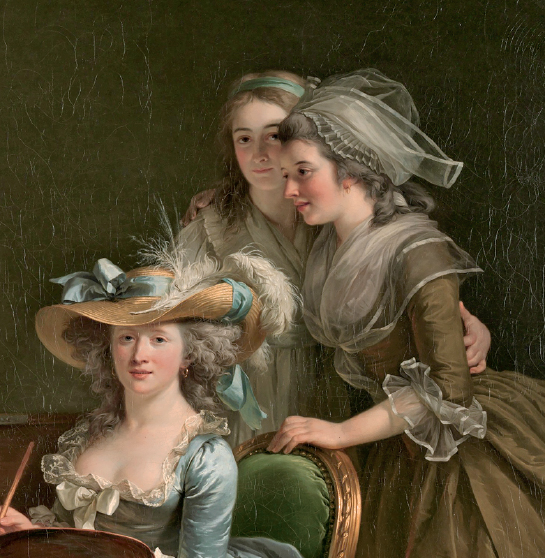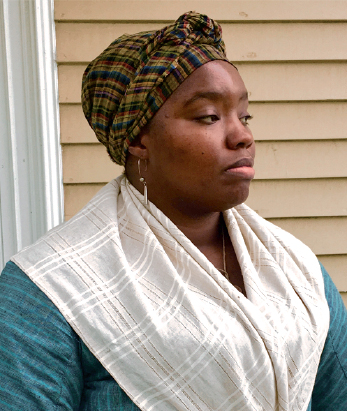

Adélaide Labille-Guiard Self-Portrait with Two Pupils, Marie Gabrielle Capet (1761–1818) and Marie Marguerite Carreaux de Rosemond (died 1788). 1785. The Metropolitan Museum of Art. 53.225.5
In this chapter, we introduce you to “crape-ing,” an original hair curling technique that will literally make your hair stand on end. Hold on to your combs; it’s about to get wild.
Crape-ing the hair was done through at least the last half of the eighteenth century. It is described by Legros in L’Art de la Coëffure des Dames Françoises in 1768 and features heavily in the illustrations in this book. [1] Crape’d hair falls out of fashion in the 1770s but returns with a vengeance in the early 1780s when the large, frizzy hairstyles come into fashion. You know that infamous portrait of Marie Antoinette in the chemise gown? [2] Yeah, that’s crape’d hair she’s rockin’. See here for our step-by-step guide to achieving this technique.
Also in this chapter, we demonstrate two pieces of large and impressive millinery to pair with your epically crape-d ’do. The Bonnet à la Jeannot cap is crisp and complex, featuring fashionable lappets in just one of many configurations popular during this period. Additionally, the black silk bonnet is both a statement piece and very useful hat to shield the eyes at outdoor events.
We hope you enjoy this fascinating period of eighteenth-century hair history. Experiment with the technique and patterns, and have fun!
A WORD ON AFRICAN HAIR IN EIGHTEENTH-CENTURY EUROPE AND THE COLONIES
BY CHEYNEY MCKNIGHT

Cheyney McKnight.
Photo by Lindsey Mulholland
Eighteenth-century Europeans viewed hair as an indicator of a person’s character. Smooth European tresses were considered to be ordered, modest and civilized. African hair was referred to as “wool,” as some did not consider it to be hair, but wool like an animal. [3] The tightly coiled, kinky hair of Africans was looked upon as wild, disordered and uncivilized. [4]
Europeans did not—or did not want to—see that the styling of hair did indeed play an important role in communicating something about the self among and between the different groups living in West Africa. One’s hair could indicate occasion, marital status, religion, familial affiliation, economic status, ethnic group, age, occupation or region. [5] West Africa had a complex system of customs and traditions that differ across hundreds of ethnic groups, and hairstyle was usually the first clue to identifying a people.
Like other bodily customs, hair varies throughout West Africa. [6] Shaved portions, cut designs, cornrows, twists, braids, dreadlocks, afros and threading are skilled techniques that were passed down through the generations. Time is dedicated daily, weekly or during ceremonies to communally tend to hair. Most transitions in life were marked by a ceremonial change in hair. Among the Wolof people a girl’s haircut would be transitioned into the longer more elaborate style of a woman’s when she attained womanhood. [7]
These varied traditions were brought over in the bellies of slave ships and trading vessels, through the memories of the human cargo to England and North America.
When the first Africans were forcibly brought to Europe and North America in the sixteenth and seventeenth centuries, they forged new traditions and rituals that connected diverse West African traditions with their new homes and status. Upon their arrival, they gradually learned how to adapt their grooming rituals to the plants, barks, roots and flowers present in these new worlds. For example, skin moisturizer and hair sealant made from shea butter processed from the shea tree throughout West Africa were replaced with animal fats. [8] The ornamental long wide-tooth picks that were used for combing springy, tightly coiled hair were remade in Europe and America using local woods and later replaced almost entirely with implements used for carding wool. [9]
However, there was no local resource that could be substituted for the time needed to create, maintain or change complex West African hairstyles. Without the time (and likely energy after long days of forced labor), enslaved Africans often wore their hair shorn, in less elaborate twists, threads, cornrows or braids, in European hairstyles, in caps and headwraps. Although in middling and gentry households the bodies of the enslaved represented a fashionable extension of the owner, the physical control over the enslaved African body seldom extended to the hair itself. [10] Control over the length of hair and head coverings seems to have been exerted more on the enslaved whose roles put them in more direct contact with guests in middling and gentry households.
Print made by Agostino Brunias, 1728–1796. A Negroes Dance in the Island of Dominica. 1779. Yale Center for British Art, Paul Mellon Collection. B1981.25.1958.
Gradually Africans in Europe and Colonial America started appropriating European styles and grooming products. Some beauty aids used by Europeans to achieve height and volume, such as hair cushions or pomades, were not always used by those of African descent, who did not need them to achieve the elaborate high hair shapes popular during the third quarter of the eighteenth century. Rather ironically, these expensive hairstyles could be more easily and cheaply achieved by Africans because of the moldability and structure of tightly coiled hair. Records show that both free and enslaved Africans used hair powder, but often made pointed efforts to retain the natural texture of their hair as a form of passive resistance to white control over their bodies and beauty standards. [11]
The hairstyles from the 1780s through the 1790s involved achieving a frizzy, rounded look surrounding the face, not at all dissimilar from an afro. This fashion required white women to twist and heat-set their hair to achieve a kinky, voluminous hairstyle similar to African hair textures. While this texture on African women was seen as an indicator of low moral control, European white women appropriated it as early as the 1750s. Tobias Smollett in 1766 described French women as:
“[…] covered with a vast load of false hair, which is Frizzled on the forehead, so as exactly to resemble the wooly heads of the Guinea negroes’.”[12]
By the 1780s, English and European white women wearing the fashionably crape’d and frizzed hairstyles did not appear to receive this same moral judgment for their artificially textured hair. Rather, being able to wear this style was seen as an indicator of wealth because of the amount of time and product that went into its creation. Despite the common verbal connection and moral connotation made between “wool” and African-textured hair, the popularity of this style makes it evident that it was not the texture of the hair, but the color of one’s skin, that was important. Scholarship has yet to identify a recognition of this irony during the time, but this suggests how much more work there is to be done on this history of African hair and hairstyles in North America.
